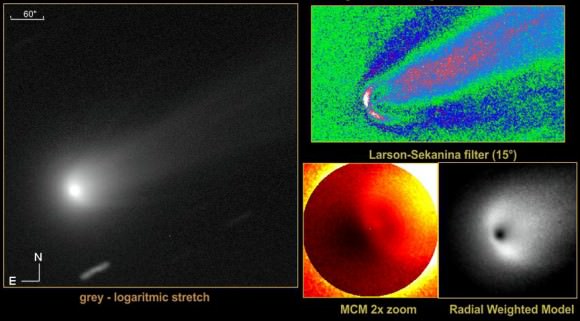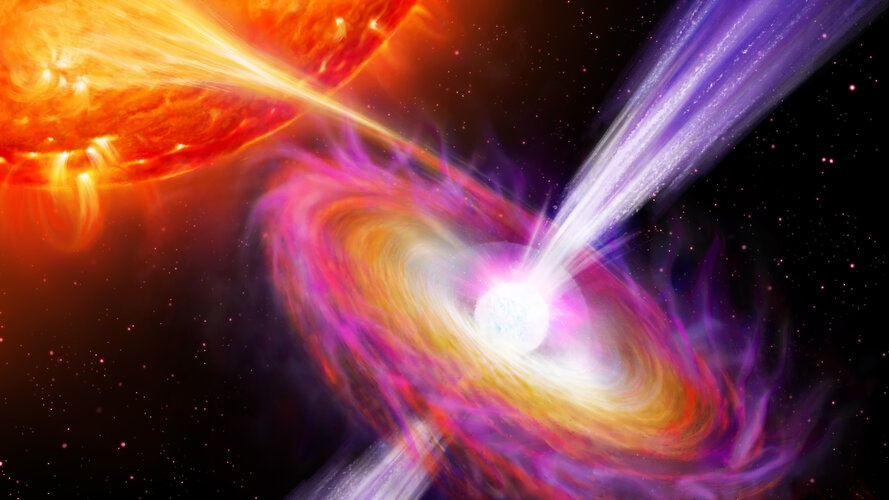It’s a well known fact that black holes absorb anything that falls into them. Often before material ‘vanishes’ inside it forms into an accretion disk around them. Like the progenitor stars, the black holes have powerful magnetic fields and these can generate jets that blast away from the black hole. A similar process occurs in neutron stars that are orbiting other stars and recent observations holes have shown that some material in the jets travel at speeds 35-40% the speed of light.
Continue reading “Neutron Stars are Jetting Material Away at 40% the Speed of Light”Dramatic Outburst at Rosetta’s Comet Just Days Before Perihelion

A comet on a comet? That’s what it looks like, but you’re witnessing the most dramatic outburst ever recorded at 67P/Churyumov-Gerasimenko by the Rosetta spacecraft. The brilliant plume of gas and dust erupted on July 29 just two weeks before perihelion.
In a remarkable display of how quickly conditions on a comet can change, the outburst lasted only about 18 minutes, but its effects reverberated for days.

The photos were taken from a distance of 116 miles (186 km) from the center of the comet. Copyright: ESA/Rosetta/MPS for OSIRIS Team MPS/UPD/LAM/IAA/SSO/INTA/UPM/DASP/IDA
In a sequence of images taken by Rosetta’s scientific camera OSIRIS, the brilliant, well-defined jet erupts from the side of the comet’s neck in the Anuket region. It was first seen in a photo taken at 8:24 a.m. CDT, but not in one taken 18 minutes earlier, and had faded significantly in an image captured 18 minutes later. The camera team estimates the material in the jet was traveling at a minimum of 22 mph (10 meters/sec), but possibly much faster.
It’s the brightest jet ever seen by Rosetta. Normally, the camera has to be set to overexpose 67P/C-G’s nucleus to reveal the typically faint, wispy jets. Not this one. You can truly appreciate its brilliance because a single exposure captures both nucleus and plume with equal detail.
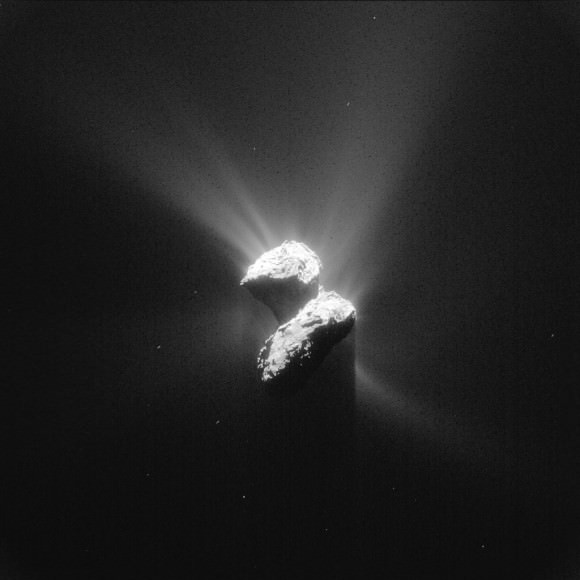
We all expected fireworks as the comet approached perihelion in its 6.5 year orbit around the Sun. Comets are brightest at and shortly after perihelion, when they literally “feel the heat”. Solar radiation vaporizes both exposed surface ices and ice locked beneath the comet’s coal-black crust. Vaporizing subsurface ice can created pressurized pockets of gas that seek a way out either through an existing vent or hole or by breaking through the porous crust and erupting geyser-like into space.
Jets carry along dust that helps create a comet’s fuzzy coma or temporary atmosphere, which are further modified into tails by the solar wind and the pressure of sunlight. When conditions and circumstances are right, these physical processes can build comets, the sight of which can fill the human heart with both terror and wonder.
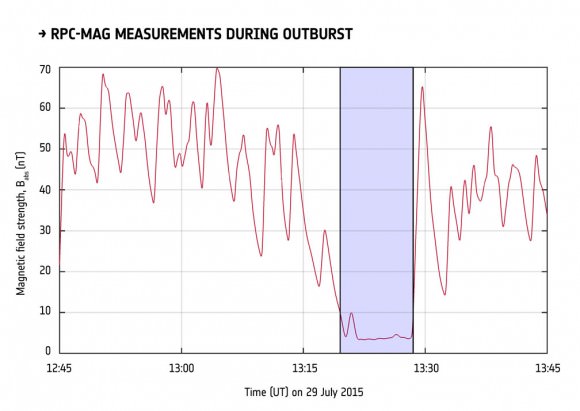
This recent show of activity may be just the start of a round of outbursts at 67P/C-G. While perihelion occurs on this Thursday, a boost in a comet’s activity and brightness often occurs shortly after, similar to the way the hottest part of summer lags behind the date of summer solstice.
Rosetta found that the brief and powerful jet did more than make a spectacle — it also pushed away the solar wind’s magnetic field from around the nucleus as observed by the ship’s magnetometer. Normally, the Sun’s wind is slowed to a standstill when it encounters the gas cloud surrounding the nucleus.
“The solar wind magnetic field starts to pile up, like a traffic jam, and eventually stops moving towards the comet nucleus, creating a magnetic field-free region on the Sun-facing side of the comet called a ‘diamagnetic cavity’,” explained Charlotte Götz, magnetometer team member, on the ESA Rosetta website.
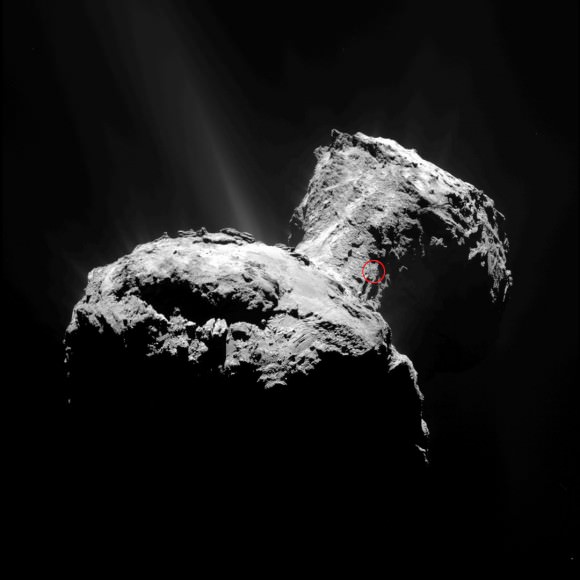
Only once before at Halley’s Comet has a magnetically “empty” region like this been observed. But that comet was so much more active than 67P/C-G and up until July 29, Halley’s remained the sole example. But following the outburst on that day, the magnetometer detected a diamagnetic cavity extending out at least 116 miles (186 km) from the nucleus. This was likely created by the outburst of gas, forcing the solar wind to ‘stop’ further away from the comet and thus pushing the cavity boundary outwards beyond where Rosetta was flying at the time.
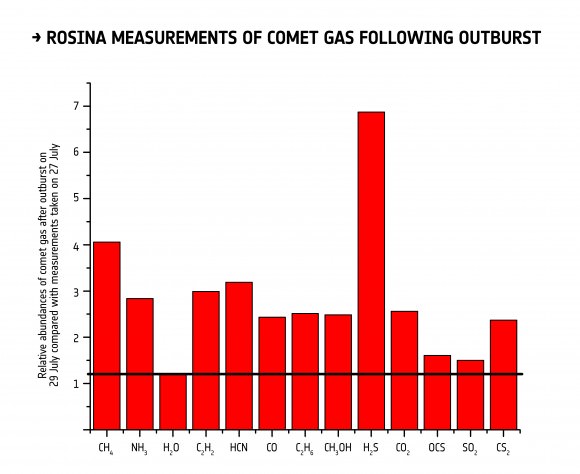
Soon afterward the outburst, the comet pressure sensor of ROSINA detected changes in the structure of the coma, while its mass spectrometer recorded changes in the composition of outpouring gases. Compared to measurements made two days earlier, carbon dioxide increased by a factor of two, methane by four, and hydrogen sulphide by seven, while the amount of water stayed almost constant. No question about it – with all that hydrogen sulfide (rotten egg smell), the comet stunk! Briefly anyway.
It was also more hazardous. In early July, Rosetta recorded and average of 1-3 dust hits a day, but 14 hours after the event, the number leapt to 30 with a peak of 70 hits in one 4-hour period on August 1. Average speeds picked up, too, increasing from 18 mph (8 m/s) to about 45 mph (20 m/s), with peaks at 67 mph (30 m/s). Ouch!
“It was quite a dust party!” said Alessandra Rotundi, principal investigator of GIADA (Grain Impact Analyzer and Dust Accumulator).
67P/C-G’s little party apparently wasn’t enough to jack up its brightness significantly as seen from Earth, but that doesn’t mean future outbursts won’t. We’ll be keeping an eye on any suspicious activity through perihelion and beyond and report back here.
Comet ISON Grows Wings; Comet Lovejoy, a Fountain
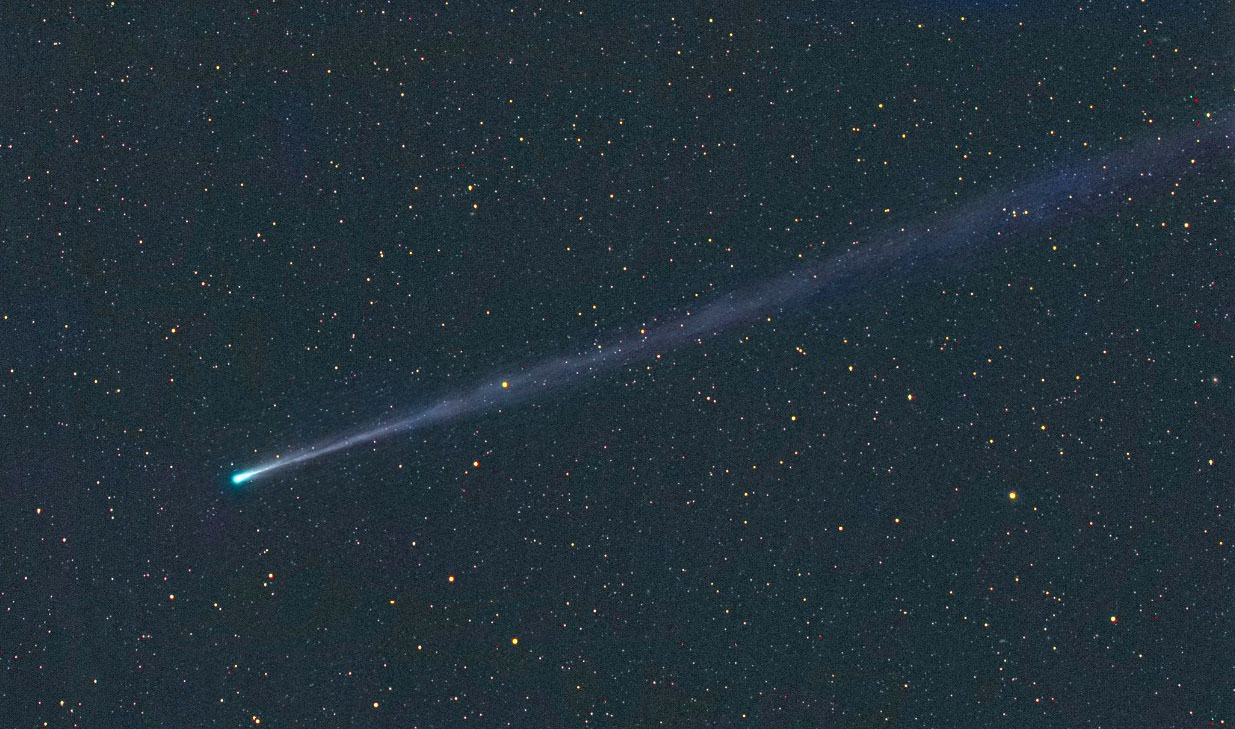
Wonderful photos of Comets ISON and Lovejoy with their swollen comas and developing tails have appeared on these pages, but recently, amateur and professional astronomers have probed deeper to discover fascinating dust structures emanating from their very cores. Most comets possess a fuzzy, starlike pseudo-nucleus glowing near the center of the coma. Hidden within this minute luminous cocoon of haze and gas lies the true comet nucleus, a dark, icy body that typically spans from a few to 10 kilometers wide. Comet ISON’s nucleus could be as large as several kilometers and hefty enough (we hope!) to survive its close call with the sun on Nov. 28.
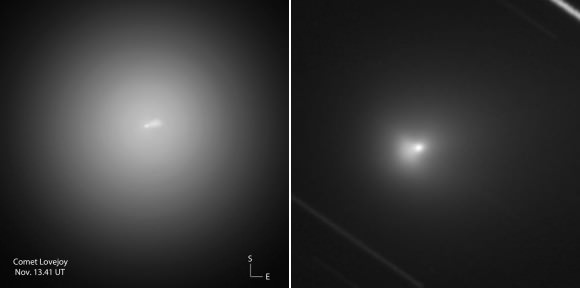
Last Wednesday morning Nov. 13 when calm air allowed a sharp view inside Comet Lovejoy’s large, 15-arc-minute-wide coma I noticed something odd about the false nucleus at low magnification, so I upped the power to 287x for a closer look. Extending from the fuzzy core in the sunward direction was a small cone or fountain-shaped structure of denser, brighter dust shaped like a miniature comet. It stretched eastward from the center and wrapped slightly to the south. Usually it’s harder than heck to see any details within the fuzzy, low-contrast environment of a comet’s coma unless that comet is close to Earth and actively spewing dust and ice. Lovejoy scored on both.
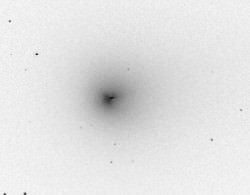
By good fortune, Dr. P. Clay Sherrod of the Arkansas Sky Observatories, USA, and Luc Arnold of Saint-Michel-l’Observatoire, France, shared images they’d made at high magnification of the identical feature right at the same time as my own observation. There’s no doubt that what we saw was a jet or combined jets of dust and vapor blasting from Lovejoy’s true nucleus. Jets are linear or fan-shaped features and carry ice, dust and even snowballs from inside the nucleus out into space. They typically form where freshly-exposed ice from breaks or fissures in the comet’s crust vaporizes in the sun’s heat.
What I wouldn’t give to see one up close. Wait – we can. Take a look at the photo of Comet 103P/Hartley made during NASA’s EPOXI flyby mission in November 2010. Notice that most of Hartley’s crust appears intact with the jets being the main contributors to the dust and gas that form the coma and tail.
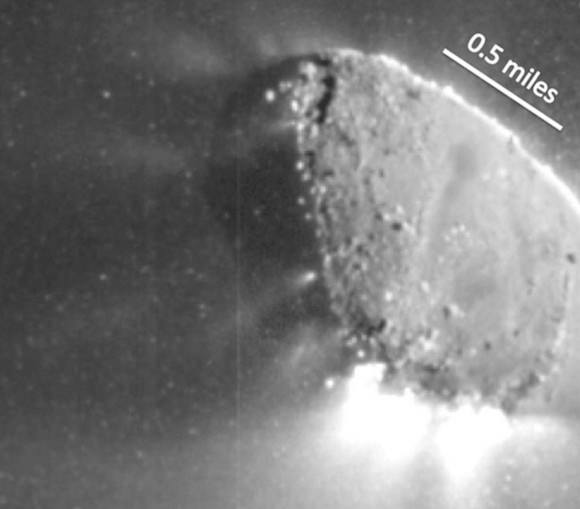
Spotting a jet usually requires good seeing (low atmospheric turbulence) and high magnification. They’re low-contrast features but worth searching for in any bright comet. Jets often point toward the sun for good reason – the sunward side of the comet is where the heating is happening. Activity dies back as the comet rotates to face away from the sun during the night and early morning hours. By studying the material streaming away from a comet via jets, astronomers can determine the rotation period of the nucleus.
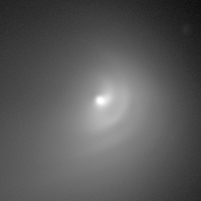
Sometimes material sprayed by jets expands into a curved parabolic hood within the coma. This may explain the wing-shaped structures poking out from Comet ISON’s coma seen in recent photos. Possibly the Nov. 13-14 outburst released a great deal of fresh dust that’s now being pushed back toward the tail by the ever-increasing pressure of sunlight as the comet approaches perihelion.
The inner coma of Comet Hale-Bopp developed a striking series of hoods in March 1997 when a dust jet spewed material night after night from the comet’s rotating nucleus. The animation captures garden sprinkler effect beautifully. Since the nucleus spun around every 11 hours 46 minutes, multiple spiraling waves passed through the coma in the sunward direction. To the delight of amateur astronomers at the time, they were plainly visible through the telescope.
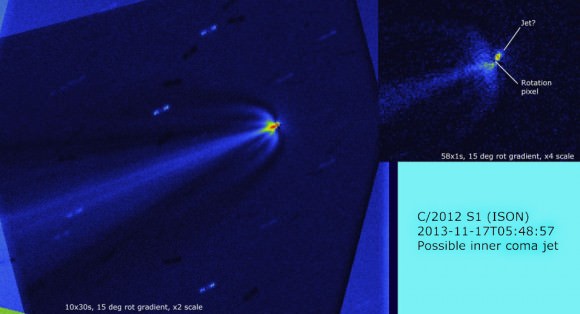
When examining a comet, I start at low magnification and note coma shape, compactness and color as well as tail form and length and details like the presence of streamers or knots. Then I crank up the power and carefully study the area around the nucleus. Surprises may await your careful gaze. If Comet ISON does break up, the first sign of it happening might be an elongation or stretching of the false nucleus. If it’s no longer a small, star-like disk or if you notice a fainter, second nucleus tailward of the main, the comet’s days may be numbered.
